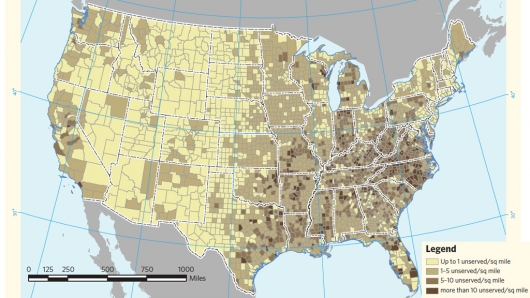Universal 4Mbps broadband comes with a US$23.5 billion price tag
By Darren Quick
00:40 May 12, 2010

The developed world is fast heading towards a globally networked information economy. Any government that fails to recognize that high-speed Internet access is fundamental to future economic growth and prosperity runs the risk of quickly ending up on the wrong end of a digital divide. While this applies to countries as a whole it also apples to residents within a country, with some spoiled for choice when it comes to broadband access while others in more remotes areas are left wanting. In a bid to ensure broadband access to all people in the U.S., the Federal Communications Commission (FCC) has set a 4Mbps download target for universal broadband with its National Broadband Plan. The undertaking will cost US$23.5 billion.
Even though the U.S. was the birthplace of the Internet and nearly 200 million Americans had broadband access at home in 2009, there are still approximately 100 million Americans who don’t have broadband access according to the FCC.
Such figures see the U.S. rank sixteenth for broadband adoption, trailing behind South Korea, Canada, Hong Kong and all of Scandinavia just to name a few. Most of the countries outdoing the U.S., with the obvious exception of Canada, have the advantage of being considerably smaller in size and therefore much easier to build a broadband infrastructure for.
Australia is another country dealing with the problem of providing universal broadband access to a large geographical area. The Australian federal government is looking to run fiber optic cable to over 90 percent of Australian homes for its National Broadband Network (NBN). It believes this will future proof a next-gen Internet infrastructure for decades by providing download speeds of 100Mbps to 90 percent of homes with minimum speeds of 12Mbps to the remainder of homes using a combination of next generation wireless and satellite technologies. The government has budgeted the NBN at AUD43 billion, but a recent study says it could be built for at least AUD5 billion less.
The FCC has taken a different tack for its National Broadband Plan saying that fiber is too expensive and that “building a future-proof network immediately is likely more expensive than paying for future upgrades." Instead, a new FCC report proposes spending US$23.5 billion to plug the gaps in the existing infrastructure that can’t currently reach 4Mbps download speeds. In underserviced areas that can’t already access broadband speeds of 4Mbps the money would be used to cover initial capital expenditure and ongoing expenses for DSL, 4G wireless or satellite, depending on the location.
Of course download speeds of 4Mbps aren’t exactly what anyone would call blazingly fast – unless they’re still surfing the Internet on dial-up. But it’s those users and others who currently have no access that will be the ones to benefit from improved speeds. However, another of the goals of the National Broadband Plan for the next decade is to give at least 100 million US homes affordable access to download speeds of at least 100Mbps and upload speeds of at least 50Mbps. Many South Korean homes already have access to 100Mbps connections and Finland plans to boost connections to such speeds by 2015.
It should be pointed out, however, that these are just goals – not something the FCC is going to enforce. Google’s plan to roll out its own 1Gbps fiber-to-the-home (FTTH) network to selected areas across the U.S. can only help the FCC’s goals become a reality.
Via Ars Technica.
Copyright © gizmag 2003 - 2010 To subscribe or visit go to: http://www.gizmag.com